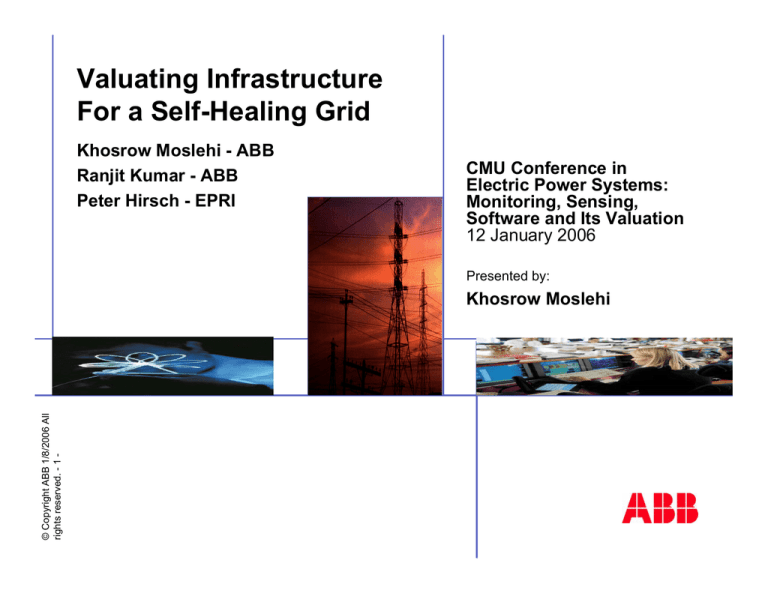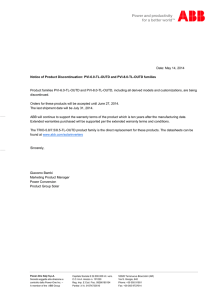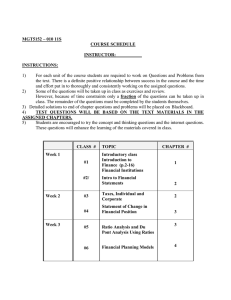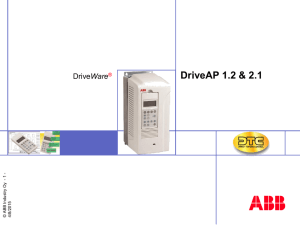
Valuating Infrastructure
For a Self-Healing Grid
Khosrow Moslehi - ABB
Ranjit Kumar - ABB
Peter Hirsch - EPRI
CMU Conference in
Electric Power Systems:
Monitoring, Sensing,
Software and Its Valuation
12 January 2006
Insert image
here
Presented by:
Khosrow Moslehi
© Copyright ABB 1/8/2006 All
rights reserved. - 1 -
Insert image
here
Insert image
here
Overview
Vision
Background
© Copyright ABB - 2 -
Architectural Framework
Analytical Framework
Valuating
Cost Models
Benefit Models
Business Cases
Costs-Benefits Analysis
Conclusion
CMU Conference in Electric Power Systems: Monitoring, Sensing, Software and Its Valuation, 11-12 January 2006
© Copyright ABB - 3 -
Background:
Self-Healing Power Grid
High reliability
Non-stop service (or graceful/minimal degradation)
Fail-proof control actions (no errors of omission or commission)
Flexible responses to various disturbances and attacks
Resource deployment to minimize impact of potential problems
Minimum possible loss of service and time to restore service
Instances of such features already exist
They need to be ubiquitous
CMU Conference in Electric Power Systems: Monitoring, Sensing, Software and Its Valuation, 11-12 January 2006
Background:
Blackout Experiences
© Copyright ABB - 4 -
Relative Phase Angle
Angular Separation 14 August 2003
~40 min.
~20 min.
~3 min.
50o
Time hhmmss
NERC
Cleveland
West Michigan (lower trajectory)
CMU Conference in Electric Power Systems: Monitoring, Sensing, Software and Its Valuation, 11-12 January 2006
Background:
Off-line Analyses May not Apply in Real-Time
Transfer study cases vs. Actual Transfers
covered by the
study cases
Actual
© Copyright ABB - 5 -
Study
TVA
CMU Conference in Electric Power Systems: Monitoring, Sensing, Software and Its Valuation, 11-12 January 2006
© Copyright ABB - 6 -
Background:
Why Self-Healing?
Power system is operated much closer to its limits
(more often!)
Qualitatively a different operating environment
(more touchy!)
Larger foot-print (more pressure on the operator!)
More volatility
More data, more automation, more control (higher
performance data processing!)
Need a higher performance IT infrastructure
CMU Conference in Electric Power Systems: Monitoring, Sensing, Software and Its Valuation, 11-12 January 2006
Background:
Large blackouts involve:
Cascading events within seconds
Aggravated by uncoordinated and unintelligent local actions
Prevention/Containment requires:
Better monitoring
Coordinated response
Sub-second response
Centralized systems are too slow
Distributed autonomous systems
© Copyright ABB - 7 -
Drivers of Architectural Innovation
Existing RAS is an early example of distributed intelligence
Any number of operating entities (RTO/ISO, TO, etc.)
CMU Conference in Electric Power Systems: Monitoring, Sensing, Software and Its Valuation, 11-12 January 2006
Background: Distributed Intelligent Agents
Distributed Agents afford:
© Copyright ABB - 8 -
Fast response
Flexible framework for various strategies
Distributed applications
Coordination
Hierarchical
Temporal
Reusable plug and play components
Greater level of reliability
CMU Conference in Electric Power Systems: Monitoring, Sensing, Software and Its Valuation, 11-12 January 2006
Distributed Agents - State Estimation Example
G SE
Agen
Grid
R SE
R SE
…
Agent
Region 1
CA SE
CA SE
Agent
Agent
Agent
SS SE SS SE
© Copyright ABB - 9 -
Region i
CA SE
C Area 11
Agent
Agent
Agent
SS1
SS2
C Area 12
SS SE
SS SE
Agent
Agent
… SSm
SS..
…..
C Area ik
SS SE
SS SE
Agent
SS…
Agent
…
CMU Conference in Electric Power Systems: Monitoring, Sensing, Software and Its Valuation, 11-12 January 2006
SS…
Background:
Distributed Autonomous System
Substations
© Copyright ABB - 10 -
Function F2
Function F1
(e.g. Voltage Stability)
Intelligent
Functional
Agent for F1
Intelligent
Functional
Agent for F1
Intelligent
Functional
Agent for F1
Region R1
Region Ri
Intelligent
Functional
Agent for F1
Intelligent
Functional
Agent for F1
Control Area Ck
Control Area C1
Intelligent
Functional
Agent for F1
Actuator
Actuator
Actuator
Substation S1
Intelligent
Functional
Agent for F1
Actuator
Actuator
Actuator
Intelligent
Functional
Agent F1
Actuator
Actuator
Actuator
Substation Sn
CMU Conference in Electric Power Systems: Monitoring, Sensing, Software and Its Valuation, 11-12 January 2006
Integrated Messaging/Data
Control Areas
Regions
Grid
Function Fi
Background:
Execution Cycles and Temporal Coordination
Slower cycles – 2 sec & over
Faster cycles - under 2 sec
Hour-Ahead
cycle
5 min
cycle
1 min
cycle
monitoring
2 sec
cycle
1 sec
cycle
100
m-sec
cycle
control
Power System
© Copyright ABB - 11 -
Including control, measurement and protection devices
Forward plans, schedules,
guidelines controls, messages
Feedback data, violations,
alerts, messages
CMU Conference in Electric Power Systems: Monitoring, Sensing, Software and Its Valuation, 11-12 January 2006
10
m-sec
cycle
Valuation of Self-Healing Grid
© Copyright ABB - 12 -
Is the IT infrastructure financially feasible?
CMU Conference in Electric Power Systems: Monitoring, Sensing, Software and Its Valuation, 11-12 January 2006
Challenges of Valuation
Framework is broad and flexible
Entire grid - All control levels, geographical areas, etc.
All analytical functions
All time scales - Milliseconds to hour
General systematic methodology
Too many context dependent parameters
Subjectivity of size, existing infrastructure & solutions, costs, benefits
Too many cost factors - R&D, SW, devices, etc.
Meaningful business cases
Too narrow - Not of interest
Too broad - Provides no specific guidelines
© Copyright ABB - 13 -
CMU Conference in Electric Power Systems: Monitoring, Sensing, Software and Its Valuation, 11-12 January 2006
© Copyright ABB - 14 -
Approach to Valuation
No specific assumptions regarding power system
Focus on IT - all cycles and all hierarchical levels
Plug-and-play intelligent agents
Functionally generic and encompassing
Configurable to existing measurement and control capabilities
Reasonable “upper bounds” on costs
Reasonable “lower bounds” on Benefits
Consider:
Incremental implementation
Shared benefits and costs
Existing SW & HW products
CMU Conference in Electric Power Systems: Monitoring, Sensing, Software and Its Valuation, 11-12 January 2006
© Copyright ABB - 15 -
What are we costing?
Software components/intelligent agents
IT hardware
System deployment and integration
Control equipment (if absolutely needed)
Not costed - Communication Connectivity
CMU Conference in Electric Power Systems: Monitoring, Sensing, Software and Its Valuation, 11-12 January 2006
Cost Models: Software Components/Intelligent Agents
R&D / Prototype Costs
Investigate/demonstrate innovative concepts and algorithms
One-time cost
Productization Costs
© Copyright ABB - 16 -
Robustness, models, solutions, performance, visualization
Integration of R&D results to standardized modules
Shakedown Costs
Database development, system configuration & integration
Maturity through multiple implementations for “plug-and-play” status:
Substation:
10 implementations
Zone/vicinity:
5 implementations
Control Area:
2 implementations
CMU Conference in Electric Power Systems: Monitoring, Sensing, Software and Its Valuation, 11-12 January 2006
Cost Models: Software Components/Intelligent Agents
© Copyright ABB - 17 -
#
Level
Prototype /
Productization
(Person-Yrs)
Field Deployment
- Shake-down
- Later implementations
1
Substation
3 / 11
- 10% for the first 10 substations (13
person-months each)
- 0.5% later (3 person-weeks each)
2
Zone/Vicinity
4 / 13
- 15% for the first 5 zones/vicinities (23
person-months each)
- 3% later(5 person-months each)
3
Control Area
10 / 30
- 25% for the first 2 control areas (90
person-months each)
-15% later (54 person-months each)
4
Region
2 / 8
- 25% for the first 2 regions (24 personmonths each)
- 15% later (14 person-months each)
5
Grid
2 / 5
- 25% for the first 2 grids (15 personmonths each)
- 15% later (9 person-months each)
Total
21 / 67
Use above formulae for various systems
CMU Conference in Electric Power Systems: Monitoring, Sensing, Software and Its Valuation, 11-12 January 2006
Cost Models: IT hardware
Measurements
Communications
PMUs as representative
Consider routers at all locations of the hierarchy
Computing
Standard computing modules each with:
© Copyright ABB - 18 -
2 CPUs (3.6 GHz or higher)
CMU Conference in Electric Power Systems: Monitoring, Sensing, Software and Its Valuation, 11-12 January 2006
Costs Model – Typical HW Requirements and Costs
#
Level
PMU/PDC
Routers
SCM
Cost/Site
1
Substation
2 PMUs
3
3
$83 k
2
Zone/ Vicinity
2 PDCs
6
4
$135 k
3
Control Area
0
4
8
$100 k
4
Region
0
1
3
$33 k
5
Grid
0
2
4
$50 k
© Copyright ABB - 19 -
200 Substations, 20 Vicinity/Zones – per CA
20 Control Areas/ Region, 10 Regions/Grid
Communications connectivity already exists
Assume $15k/PMU, $22.5k/router and $7.5k/computer
CMU Conference in Electric Power Systems: Monitoring, Sensing, Software and Its Valuation, 11-12 January 2006
Costs Model – System deployment and integration
© Copyright ABB - 20 -
Efforts for different levels and stages include:
DB development
Configuration
Integration
Field verification
etc.
Cost roughly proportional to the number of
substations
Integration cost – system dependent
Typically 30% of total cost of SW deployment & HW
CMU Conference in Electric Power Systems: Monitoring, Sensing, Software and Its Valuation, 11-12 January 2006
© Copyright ABB - 21 -
Cost Models: Control Equipment
Where absolutely necessary
Consider shunt FACTS devices as representative
Potentially about 10% of transmission system
supplied reactive requirements through FACTS
Translates to 4 MVAr per 100 MW peak load
Costed at $50k/MVAr
CMU Conference in Electric Power Systems: Monitoring, Sensing, Software and Its Valuation, 11-12 January 2006
Benefits Model – Which benefits?
Limit improvement:
Blackout containment:
© Copyright ABB - 22 -
Improved market prices/production
costs
Reduced unserved energy
Possible others:
Σ
Reduction of emergency
maintenance costs
Deferral of capital expenses
Improved power quality
Etc.
Reduced Prices/
Production Costs
Selected
Benefits
Reduced
Unserved
Energy
Reduced
Emergency
Maintenance
CMU Conference in Electric Power Systems: Monitoring, Sensing, Software and Its Valuation, 11-12 January 2006
Potential
Benefits
Benefits Models - Limit Improvements
© Copyright ABB - 23 -
Ideal limit order
Thermal being the binding limit
Stability Limit
Stability Limit
Voltage Limit
Voltage Limit
Thermal Limit
Thermal Limit
Thermal Limit
Voltage Limit
Stability Limit
Actual Operation
Actual Operation
Actual Operation
Voltage Limit
Thermal Limit
Thermal Limit
Stability Limit
Stability Limit
Voltage Limit
Thermal Limit
Voltage Limit
Stability Limit
Actual Operation
Actual Operation
Actual Operation
CMU Conference in Electric Power Systems: Monitoring, Sensing, Software and Its Valuation, 11-12 January 2006
Limit Improvements – Less Expensive MWh
Estimated price differential
Estimated effective hours/year
Capacity factor of CC
Typically 45%
Possible Limit Improvement
© Copyright ABB - 24 -
Gas CC vs Coal
Typically $20/MWh
Transfer limit
1% of base load
Analytically justified
Weighted Average LMPs for PJM Market - 2004
CMU Conference in Electric Power Systems: Monitoring, Sensing, Software and Its Valuation, 11-12 January 2006
Limit Improvements - Industry Statistics for Parameters
#
Description
Range in
Industry
Statistics
Sources
Value used in this
project
1
LMP
Differentials
$0-$438
/MWh
Delmarva Study,
NYISO real-time LMP’s
PJM State of the Market
$20/MWh
2
Hours with
high LMP’s
(>$45/MWh)
45% =
3942 hrs/Yr
3942hrs /Yr
PJM State of the Market
Report
Base load MW
at Low LMP’s
80% of
average load
PJM State of the Market
Report
80% of average load
0-1136 MW
Delmarva study,
1% of base load for
45% of the hours
1888 MW
/TLR Event
TLR report
3
($0-$25)/MWh
© Copyright ABB - 25 -
4
Average MW
affected
CMU Conference in Electric Power Systems: Monitoring, Sensing, Software and Its Valuation, 11-12 January 2006
= ~ 31.5 Sys.Hrs/Yr
Limit Improvement - Validation of Model
Model: Entire US
Description
Value
Effective congested hours (45%)
3942 hr/Yr
1% of base load for entire U.S.
3,560 MW
Potential Impact
14,034 GWh/Yr
Industry:
#
Description
GWh/Yr
1
Congested GWh in Top 20 paths in Eastern Grid
107,470
(National Transmission Grid Study Report)
2
Congested GWh in Top 20 paths in Western Grid
38,548
© Copyright ABB - 26 -
(National Transmission Grid Study Report)
3
Energy schedules cut by TLR’s (Eastern Grid - actual)
(NERC TLR data)
CMU Conference in Electric Power Systems: Monitoring, Sensing, Software and Its Valuation, 11-12 January 2006
3,468
Benefits Models - Unserved Energy
Residential Cust. ($/kwh)
Commercial Cust. ($/kwh)
Industrial Cust. ($/kwh)
Published
Information
Average Unserved Mwh
due to Transmission
Outages
Weighted Average Value $/kwh
Reduction in
Unserved Energy
(Mwh)
© Copyright ABB - 27 -
Benefit: Reduction in Unserved Energy ($)
CMU Conference in Electric Power Systems: Monitoring, Sensing, Software and Its Valuation, 11-12 January 2006
Unserved Energy
- Parameters for Valuating
# Description
1
© Copyright ABB - 28 -
2
Service interruptions
due to transmission
problems ignoring
major disturbances
Interruptions due to
major disturbances due
to transmission
problems
3
Fraction of the above
that could be avoided
4
Value of unserved
energy
Range
4-22
Systemminutes
per year
0-133
Systemminutes
per year
------$1,000$361,000
/MWh
Sources
Value
used
- PG&E, Reliability Indices
Report submitted to CPUC
(10 year history)
- TVA
- NERC/DAWG Database
(Year 2002)
10
sys.min.
per year
- PG&E, Reliability Indices
Report submitted to CPUC
(10 year history).
20
sys.min.
per year
- Analytically justified
PG&E, Ontario Hydro, SCE
and other studies –
adjusted for inflation
CMU Conference in Electric Power Systems: Monitoring, Sensing, Software and Its Valuation, 11-12 January 2006
10%
$24,000/M
Wh
Benefit Models: Unserved Energy Value ($/MWh)
© Copyright ABB - 29 -
Sector
Residential
PG&E
1990
$/MWh
4,640
PJM
Inflation
. Factor
1.42
2004
$/MWh
Commercial
31,630
1.42
44,910
Industrial
10,770
1.42
15,290
Agricultural
3,670
1.42
5,210
Weighted
16,930
1.42
24,040
6,590
Source:
PG&E report (1990) quoted in PJM white-paper (2004) on
“Future PJM Capacity Adequacy Construct- The Reliability Pricing Model”
CMU Conference in Electric Power Systems: Monitoring, Sensing, Software and Its Valuation, 11-12 January 2006
Business Case – Model for Full Scale Implementation
© Copyright ABB - 30 -
A reasonably large control area embedded in an
interconnection
#
Description
Value
1
Peak load
20,000 MW
2
Average load
12,500 MW
3
Base load
10,000 MW
5
Substations
200
6
Vicinities/zones
20
CMU Conference in Electric Power Systems: Monitoring, Sensing, Software and Its Valuation, 11-12 January 2006
Full Scale Implementation – Total Deployment Cost
#
Description
Cost ($K)
1
SW Deployment Subtotal
11,400
2
IT Hardware
19,400
3
System Integration
9,240
(30% of SW & HW)
© Copyright ABB - 31 -
Deployment Total
40,040
CMU Conference in Electric Power Systems: Monitoring, Sensing, Software and Its Valuation, 11-12 January 2006
Full Scale Implementation –
Costs and Benefits Summary
Item
SW + HW + Integration
Control Equipment
K$
40,040
N/A
Total Costs
40,040
Limit improvement benefit
39,420
Avoided unserved energy benefit
75,000
Total Benefits
114,420
© Copyright ABB - 32 -
• SW implementation cost includes deployment at 200 substations, 20
vicinities, and the control area as well as interfaces with region and grid
• The SW development cost of $34 M to be distributed/licensed
CMU Conference in Electric Power Systems: Monitoring, Sensing, Software and Its Valuation, 11-12 January 2006
Partial Implementation Problem 1 -
EHV Outage Stresses HV System
When one of the EHV lines is out for maintenance, the contingent outage of
another EHV line places severe stress on the underlying HV system.
© Copyright ABB - 33 -
900 MW
1200 MW
CMU Conference in Electric Power Systems: Monitoring, Sensing, Software and Its Valuation, 11-12 January 2006
Partial Implementation Problem 2 - Voltage Collapse
When one line is down due to maintenance or forced outage, the (N-1) reliability
criterion is not met. The underlying sub-transmission system will be subject to
voltage collapse if another line fails.
161kV
161kV
161kV
© Copyright ABB - 34 -
CT’s
4x80
MW
CMU Conference in Electric Power Systems: Monitoring, Sensing, Software and Its Valuation, 11-12 January 2006
Partial Implementation Problems - Costs and Benefits
#
Description
Amount
($K)
1
Problem 1
1.1
Cost (at 3 substations)
1.2
Total Benefits
~ 60,000
1.3
Benefit / Cost
~149
2
Problem 2
2.1
Cost (at 3 substations)
~ 400
2.2
Total Benefits
2,660
2.3
Benefit / Cost
~6.67
~ 400
© Copyright ABB - 35 -
• All software and hardware has matured in prior implementations.
• Only interfaces necessary for the two specific problems are included
CMU Conference in Electric Power Systems: Monitoring, Sensing, Software and Its Valuation, 11-12 January 2006
© Copyright ABB - 36 -
Empirical Models – Costs and Benefits
CMU Conference in Electric Power Systems: Monitoring, Sensing, Software and Its Valuation, 11-12 January 2006
Conclusions
© Copyright ABB - 37 -
Systematic and general methodology to translate
broad scope into quantifiable costs and benefits
Identification of significant cost components
Identification of financially significant benefits
Scalable framework of models to assess reasonable
“upper bounds” on costs and “lower bounds” on benefits
for localized or system-wide implementations
Validation of the models against industry statistics.
Analytical justification of model parameters.
Development of an empirical model to facilitate feasibility
analysis
CMU Conference in Electric Power Systems: Monitoring, Sensing, Software and Its Valuation, 11-12 January 2006
Conclusions
© Copyright ABB - 38 -
Inevitable grid-wide penetration of self-healing
capabilities:
First implementation would substantially bring down the “entry
barrier” for the remaining utilities to a level comparable to
traditional control centers
Steady decline of cost of computing power
Value of benefits continue to increase as the economy and
quality of life become more dependent on a reliable power grid
For the entire U.S. , benefits (billions of $) would far exceed
initial R&D costs of $65M
The above conclusion remains valid and unaffected
by any reasonable changes in the specific values
of the parameters used in the calculations.
CMU Conference in Electric Power Systems: Monitoring, Sensing, Software and Its Valuation, 11-12 January 2006








